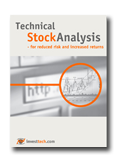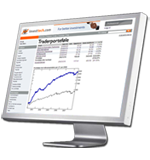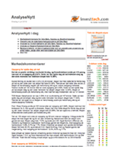try to get document id 75851
try to get document id 75851
try to get document id 75851
Investtech Research: Support and resistance are important indicators
Published 6 November 2023
Previous Investtech research based on data from the period 2008-2020 showed that when the stock price was significantly above support and lacked resistance, a period followed that on average resulted in excess return compared to the rest of the market. The same analyses have now been conducted using data from the period 2020-2022. The results are consistent. They indicate that such signals during the period 2020-2022, on average, have led to significant excess return compared to the rest of the market. We observe that the corresponding sell signals, where the stock price is significantly below resistance and lacks support, on average, resulted in negative excess return vs benchmark. This is also consistent with previous findings. These signals are considered important, and it is assumed that they can be applied in trading strategies involving listed stocks.
We have previously examined the price movements that followed buy signals defined as situations where the stock price is above support and lacks resistance in Investtech's price charts. The universe included listed stocks in Norway, Sweden, Denmark, and Finland. Based on signals from the period 2008-2020, we concluded that such buy signals, on average, outperformed the market.
As a follow-up to this research, we have examined the same types of signals identified in the period 2020-2022. This article summarizes the new results and compares them with the previous ones to assess their consistency and validity.
Buy Signals: Stocks above support and lacking resistance
The chart below shows average price development following buy signals when the stock price is above support and lacks resistance. The signals are triggered on day 0, and we have examined the development up to day 66. Only days when the stock exchange is open are included, so 66 days correspond to approximately three months. The thick blue line illustrates how stocks with buy signals performed. The shaded area represents the standard deviation of the calculations. The narrow blue line shows how the benchmark index performed during the same period when measuring the development of the stocks with buy signals.
Figure 1: Nordic markets combined. Return from stocks with buy signals identified in Investtech's medium-term price charts. Thick blue line represents the signal stocks, thin blue line represents benchmark. Nordic markets 2020-2022.
The figure illustrates that buy signals outperform benchmark, and excess return increases steadily during the first 66 days after the signal date. After 66 days, stocks with buy signals, on average, have increased by 4.9 per cent, while the reference index has risen by 3.1 per cent.
The table below shows annualised return and excess return based on the 66-day figures for each of the Nordic countries, as well as a weighted average for the Nordic markets combined.
| Annualised return (based on 66-day figures) | Norway | Sweden | Denmark | Finland | Weighted average |
| Buy signal | 23.6 % | 18.2 % | 19.0 % | 22.5 % | 20.0 % |
| Benchmark in same period | 11.4 % | 12.1 % | 16.1 % | 11.4 % | 12.2 % |
| Excess return buy signal | 12.2 pp | 6.1 pp | 2.9 pp | 11.1 pp | 7.8 pp |
pp = percentage points
Overall, stocks with buy signals outperformed benchmark by an annualised excess return of 7.8 percentage points in the period following the signals. For the period 2008-2020, the corresponding figure was 10.1 percentage points better than benchmark.
Sell Signals: Stocks below resistance and lacking support
The chart below shows the performance of stocks that are below a resistance level and lack support.
Figure 2: Nordic markets combined. Return following sell signals from stocks significantly below resistance and lacking support identified in Investtech's medium-term price charts. Thick red line represents the signal stocks, thin red line represents benchmark. Nordic markets 2020-2022.
The figure illustrates that stocks below resistance and lacking support clearly underperform compared to the rest of the market. They show a relatively neutral development in the first 3 months, while benchmark increases by 4 per cent during the same period. The table below shows the annualised return for stocks with such sell signals.
| Annualised return (based on 66-day figures) | Norway | Sweden | Denmark | Finland | Weighted average |
| Sell signal | -3.6 % | 0.8 % | 10.3 % | 5.4 % | 1.0 % |
| Benchmark in same period | 16.8 % | 14.0 % | 28.1 % | 17.6 % | 16.1 % |
| Excess return sell signal | -20.3 pp | -13.1 pp | -17.8 pp | -12.2 pp | -15.1 pp |
It is evident that stocks significantly below resistance and lacking support have, on average, significantly underperformed vs benchmark during the same period. On average, such sell signals resulted in an annualised negative excess return of 15.1 percentage points. For the period 2008-2020, these sell signals led to a negative excess return of 7.1 percentage points.
Summary
Buy signals from stocks above support and lacking resistance in the period 2020-2022 have, on average, outperformed the rest of the market. The difference is considered significant, with an annualised excess return for the signal stocks of 7.8 percentage points.
Sell signals from stocks below resistance and lacking support in the period 2020-2022 have, on average, performed weaker than the rest of the market. The difference is considered significant, with an annualised negative excess return for the signal stocks of 15.1 percentage points.
These results confirm and reinforce the findings from earlier research on similar signals from the period 2008-2020.
Such signals are considered important, and we believe that they can be applied in trading strategies involving listed stocks.
Keywords: h_Res,h_Sup.
Written by

Analyst
at Investtech
Articles:
Buy signal when stock is above support and lacks resistance
Research report (in Norwegian):
Støtte og motstand - signalstatistikk Norden 2008-2020
"Investtech analyses the psychology of the market and gives concrete trading suggestions every day."

Partner & Senior Advisor - Investtech
Investtech guarantees neither the entirety nor accuracy of the analyses. Any consequent exposure related to the advice / signals which emerge in the analyses is completely and entirely at the investors own expense and risk. Investtech is not responsible for any loss, either directly or indirectly, which arises as a result of the use of Investtechs analyses. Details of any arising conflicts of interest will always appear in the investment recommendations. Further information about Investtechs analyses can be found here disclaimer.
The content provided by Investtech.com is NOT SEC or FSA regulated and is therefore not intended for US or UK consumers.
Investtech guarantees neither the entirety nor accuracy of the analyses. Any consequent exposure related to the advice / signals which emerge in the analyses is completely and entirely at the investors own expense and risk. Investtech is not responsible for any loss, either directly or indirectly, which arises as a result of the use of Investtechs analyses. Details of any arising conflicts of interest will always appear in the investment recommendations. Further information about Investtechs analyses can be found here disclaimer.
The content provided by Investtech.com is NOT SEC or FSA regulated and is therefore not intended for US or UK consumers.


 Oslo Børs
Oslo Børs Stockholmsbörsen
Stockholmsbörsen Københavns Fondsbørs
Københavns Fondsbørs Helsingin pörssi
Helsingin pörssi World Indices
World Indices US Stocks
US Stocks Toronto Stock Exchange
Toronto Stock Exchange London Stock Exchange
London Stock Exchange Euronext Amsterdam
Euronext Amsterdam Euronext Brussel
Euronext Brussel DAX
DAX CAC 40
CAC 40 Mumbai S.E.
Mumbai S.E. Commodities
Commodities Currency
Currency Cryptocurrency
Cryptocurrency Exchange Traded Funds
Exchange Traded Funds Investtech Indices
Investtech Indices


